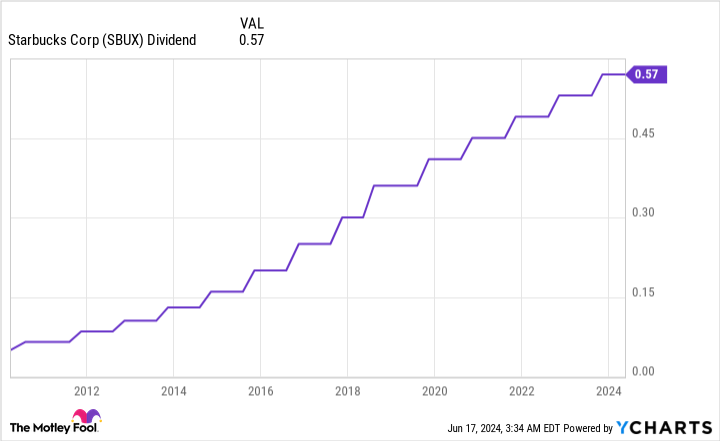Over the last century, no asset class has generated a higher average annual return than stocks. With thousands of publicly traded companies and exchange-traded funds for investors to choose from, investors of all walks and risk tolerances are likely to find a security that meets their goals and grows their wealth.
But among the countless strategies investors have at their disposal, few have been more successful than buying and holding dividend stocks.
Last year, the investment advisors at Hartford Funds released an extensive report (“The Power of Dividends: Past, Present, and Future”) that examined the outperformance of dividend stocks over the last half century (1973-2023). In a collaboration with Ned Davis Research, Hartford Funds found that dividend stocks more than doubled the average annual return of non-payers over 50 years: 9.17% versus 4.27%.
Additionally, dividend-paying stocks have proved to be less volatile. While the non-payers were 18% more volatile than the S&P 500 and produced modest returns over 50 years, the dividend stocks were 6% less volatile than the benchmark index. Companies that regularly share a percentage of their profits with investors tend to be profitable on a recurring basis and time-tested — thus, the lower volatility.
While the Dow Jones Industrial Average and S&P 500 are known for their dividend-paying companies, you might be surprised to learn that the growth-focused Nasdaq-100 is home to a number of fantastic income stocks, as well.
Right now, two beaten-down, high-yield Nasdaq-100 stocks are ripe for the picking and begging to be bought by opportunistic investors. Note: “high-yield” refers to any stock whose yield is at least two times higher than the current yield of the S&P 500 (1.34%, as of June 14, 2024).
Time to pounce: Starbucks (2.9% yield)
The first high-octane Nasdaq-100 income stock that’s makes for a no-brainer right now is global coffee chain Starbucks (NASDAQ: SBUX). Shares of the company have declined by 37% since hitting an all-time high in 2021, which has, in turn, lifted its dividend yield to nearly 3%.
There’s no beating around the bush that Starbucks’ fiscal second-quarter operating results stunk. Starbucks has a lengthy track record of blowing Wall Street’s generally conservative growth estimates out of the water. But the coffee behemoth reported a global same-store sales decline of 4% and, once more, lowered its full-year sales forecast for fiscal 2024, which’ll end in late September.
The culprits for this weakness look to be a combination of higher input costs (both labor and coffee), the company’s new drinks not resonating with consumers, and China’s economic rebound from three years of stringent COVID-19 lockdowns taking longer than expected. While there are no excuses to be made, none of these headwinds are long-term in nature.
For example, Starbucks has an exceptionally loyal customer base. The company closed out March with 32.8 million active Rewards Members in the U.S., which is up 6% from the prior-year period. Rewards Members usually spend more per ticket than non-members, and they’re likelier to lean on mobile ordering and store their credit card information on their smartphone. Simple things like mobile ordering and storing payment information on smartphones expedites in-store lines and makes Starbucks’ stores more efficient over time.
To add to this point, Starbucks has never been afraid to increase the price of its beverages or food items to counter rising costs. Having a loyal customer base makes it easy for the company to fight back against inflation and the occasional minor dip in foot traffic.
Sales weakness in China isn’t something to be overly concerned about yet, either. It’s going to take time for China’s economy to work out the supply chain kinks that have followed three years of very stringent provincial pandemic lockdowns. As China’s middle class finds its footing, there’s likely to be a greater incentive for these consumers to revisit their local Starbucks.
However, the top reason to trust in Starbucks over the long run is its innovative capacity. A perfect example being Starbucks completely overhauling its drive-thru ordering boards during the pandemic. It installed video to personalize the drive-thru experience, as well as promoted high-margin drink and food pairings on its ordering boards. The company has also been tinkering with new food items to encourage the lunch crowd to visit its stores.
Although Starbucks is working through an undeniable grind at the moment, the company has a history of using drink, food, and technological innovations to drive foot traffic into its stores. The company’s forward price-to-earnings (P/E) ratio of less than 20 marks a decade low and represents a 30% discount to its average forward P/E multiple over the last five years.

Time to pounce: Walgreens Boots Alliance (6.4% yield)
The other beaten-down, high-yield Nasdaq-100 stock that opportunistic investors can pounce on right now is pharmacy chain Walgreens Boots Alliance (NASDAQ: WBA). Shares of Walgreens have plummeted by 84% since hitting an all-time of high nearly $100 per share in 2015.
Walgreens has been contending with no shortage of headwinds over the last couple of years. It’s facing growing online pharmacy competition, has dealt with litigation regarding its role in the opioid crisis, and is attempting to dig its way out of a mountain of debt. The company’s dividend was also reduced by nearly 50% in January 2024. Long story short, there are viable reasons why Walgreens’ stock is struggling.
Although turnarounds for brick-and-mortar retailers aren’t short-term events, the framework is being laid for Walgreens Boots Alliance stock to eventually do a 180 for value- and income-seeking investors.
As I’ve previously pointed out, the most-important of all changes undertaken by Walgreens was the hiring of Tim Wentworth as CEO. Wentworth is the former CEO of pharmacy-benefit management company Express Scripts, as well as Evernorth, Cigna‘s health-services organization. The key point being that Wentworth has an extensive background in healthcare, which is something former CEO Rosalind Brewer lacked. With an experienced CEO in place, Wentworth can tackle Walgreens’ problems head-on.
As is to be expected with any turnaround, Walgreens is tightening its belt. After successfully reducing its operating expenses by $2 billion, as of the end of fiscal 2021 (the company’s fiscal year ends on August 31), the new plan is to increase annual cost savings to an aggregate of $4.1 billion. Cost-cutting should improve margins and allow the company to whittle down some of its outstanding debt.
I’ll add to the above that selling non-core assets is also on the table to reduce debt. There’s speculation that Walgreens may opt to sell its Boots franchise in the U.K., which would improve the financial flexibility of its balance sheet.
But there’s more to this turnaround than just cutting costs. Walgreens’ management team has been willing to spend aggressively on a variety of digital initiatives. In particular, the company has revamped its supply chain and built out its online website. Even though its physical stores generate the bulk of its sales, direct-to-consumer sales offer a path to sustained organic growth.
The other big change is Walgreens Boots Alliance’s shift to healthcare services. While moving into new verticals has a learning curve — the company took a hefty non-cash writedown on its investment in VillageMD in its most recent quarter — it’s a smart move for a company aiming to improve customer loyalty at the grassroots level.
Though things may look bleak on paper for Walgreens Boots Alliance, the company’s transformation efforts are well underway. At roughly 5 times forward-year earnings, and with a 6.4% yield in tow (the highest yield in the Nasdaq-100), all the negative news (and some) appears to be fully baked into the company’s prospects.
Should you invest $1,000 in Starbucks right now?
Before you buy stock in Starbucks, consider this:
The Motley Fool Stock Advisor analyst team just identified what they believe are the 10 best stocks for investors to buy now… and Starbucks wasn’t one of them. The 10 stocks that made the cut could produce monster returns in the coming years.
Consider when Nvidia made this list on April 15, 2005… if you invested $1,000 at the time of our recommendation, you’d have $808,105!*
Stock Advisor provides investors with an easy-to-follow blueprint for success, including guidance on building a portfolio, regular updates from analysts, and two new stock picks each month. The Stock Advisor service has more than quadrupled the return of S&P 500 since 2002*.
*Stock Advisor returns as of June 10, 2024
Sean Williams has positions in Walgreens Boots Alliance. The Motley Fool has positions in and recommends Starbucks. The Motley Fool has a disclosure policy.
Time to Pounce: 2 Beaten-Down, High-Yield Nasdaq-100 Stocks That Are Begging to Be Bought Right Now was originally published by The Motley Fool
Signup bonus from





